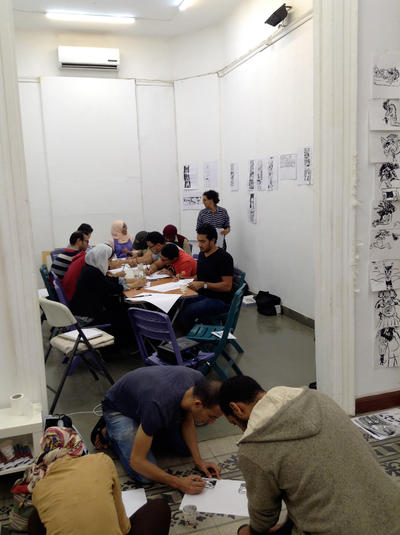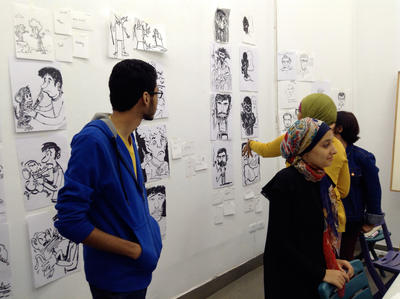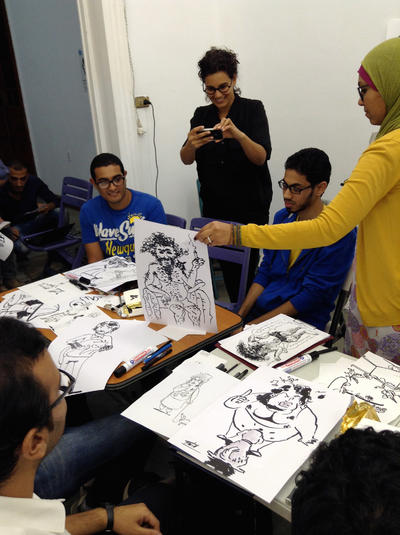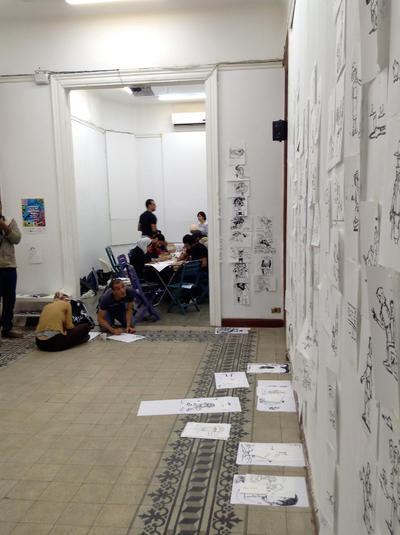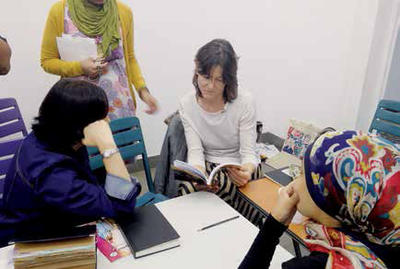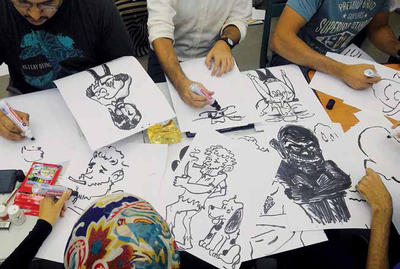-
Drawing against repression
Workshop during 2nd Egypt Comix Week in Cairo in 2015
In collaboration with Julia Marti
Mohamed El-Baalys NGO: Sefsafa Publishing House & Culture
Website Amado Alfadni
-
-
2nd Egypt Comix Week in Cairo
As we drive from the airport in the direction of the city centre in a rickety taxi at three o’clock at night, we experience the last quiet minutes. From then on, constant honking surrounds us day and night. Every few hours, muezzin calls in varying degrees of pleasantness echo from tinny loudspeakers and rattling speakers send out loud music onto the bustling streets. Everybody sits outside, smoking shisha in cafés, playing, picnicking on dusty roadsides or selling fruit. It is teeming with street peddlers and cats. People talk loudly and gesticulate. A smile is returned beamingly and is accompanied by «Welcome to Egypt». If I did not know that repression dominates the country, that critical thinking and acting is punished with torture and arrest, I would consider myself in a place brimming with life.
Masterly mainstream illustrators
Julia Marti and I have been invited to Egypt Comix Week and hold a workshop sponsored by Pro Helvetia. Our course room is in Medrar, a space for contemporary art. The taxi driver cannot immediately find the place in Garden city. Time and again, he asks other car drivers for advice through the open window. We arrive late, but we are by no means the last ones – it seems normal, an hour does not make a difference. They are nice, simple rooms in a villa from the colonial era coated with patina. There is only bright neon light, two small tables and plastic chairs for all twelve participants in the room: ten men and only two women. We have Ahmed Omar from the festival organisation team as an all round support. Mona Feise, a young woman from Germany, and Amira Alhosainy interpret. It soon becomes clear that most workshop participants are very adept drawers and are strongly influenced by mainstream comics. At first, our playful exercises for idea generation confuse them. They find it hard to draw quietly und it is unusual for us to teach in such a lively atmosphere. Luckily, we find a third table. Still, there is hardly enough room for all the sheets, some work on their knees and on the floor. We draw figures and copy one another, pose short time limits and hand out thick felt pens. For most of them, all of this is new ground. At the end of the first day, we discuss what has emerged. This is also an unfamiliar practice fort them. In one of the rooms next door, there is an exhibition of the works of young Romandy artist Barbara Meule. Everyone who has seen her installation at this year’s Fumetto Comix-Festival in Luzern knows that she has a special artistic style in dealing with sequential imagery. We are happy about the subversive neighbour and about festival curator Mohamed El-Baaly inviting her. When I ask him why he started the festival two years ago, the former journalist explains that he tries to spread the art form in his country for political reasons. Afterwards, we go to the opening of an exhibition of Egyptian illustrators. There, a reporter interviews me about my work. One of our workshop participants translates to Arabic. When I talk about my newest comic story about a young lesbian woman in Russia, she leaves that part out. -
Graffiti witnesses of the riots
Later, we travel many kilometres on foot through Cairo’s pulsating nightlife. Ahmed is our constant companion and shows us how to cross the incredibly heavily trafficked streets without a zebra crossing. We pass Tahrir Square for the first time and walk along long walls with graffiti art from the latest revolution. Ahmed says he did not spray graffiti, but of course he was part of the demonstrations as a young artist. He says that in a sad way and falls silent, as if he does not want to be reminded.
We spend the next day with more Swiss drawing exercises. Another novelty that proves popular is that we partly drop the hierarchy between course instructor and participant. We devote ourselves to developing characters and scenes, rely on free drawing with the brush and reinforce the participants’ own way of expression, finding individually shaped traits and figures that leave room for interpretation. Next on the agenda are panel exercises. Occasionally, the muezzin calls and some of our participants disappear into the room next door for praying, put a small carpet on the floor and are completely within themselves. It moves me; I perceive it as an intimate act and quickly look away.
Protest with posters
The presentation of our own work raises many questions and sparks an animated discussion about our job and design attitude. In the evening, Ahmed takes us downtown to artist friend Amado Alfadni, who is originally from Sudan. At his place, we drink beer, which is not allowed in public. He shows us a project for which he has put up posters everywhere in the city and outside. In beautiful Arabic letters, they invite people to note down on the empty space what they want from an ideal government, an ideal president. He was searched for because of that and was to be arrested. Luckily, he was in Germany at the time. Later, he tells me about the days of demonstrations. On his way home, many stretches of road were cordoned off. People in uniform tried to arrest people. A courageous owner of a garage hid Amado and some other people in the mechanic’s hatchway under the cars. The garage owner stood up and forbid the security people to take people from his private property. A scuffle erupted; some were able to escape, including Amado. A few weeks later, the two men met accidentally at a café. Before the scene had taken place, they never exchanged a word; they only knew one another by sight. They hugged each other and were both happy to be alive. He gave the stretch of road a wide berth for at least a year after that. About the current elections, Amado says that he has given up hope. During the revolution, there was an enormous amount of positive power and the belief that something could be changed. But there was also a lot of risk. Some of his friends have since been arrested or killed. On the workshop’s last day, we draw stories together. Everyone joins in, even the interpreter and the volunteers from the festival organisation team. An exuberant, happy mood seizes everyone.
-
-

